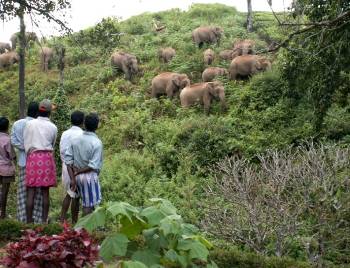A new study in Tropical Conservation Science has found that Asian elephants living in a combination of fragmented forests and agricultural landscapes still depend on natural landscapes—rivers and forests—for survival. Following two herds of Asian elephants (Elephas maximus) in the Valparai plateau among the Anamalai Hills of India for three years, researchers found that the elephants spent much of their time, relative to their availability, near rivers and amid forest fragments. When they entered agricultural landscapes they preferred Eucalyptus and coffee to tea.
One third of the researchers’ elephant locations were along rivers or in natural forest, even though these landscapes made up less than 5 percent of the landscape. Elephants were located in tea plantations 32 percent of the time, and Eucalyptus 17 percent and coffee 13 percent of the time. However, given that tea plantations cover most of the region, the elephants actually avoided tea as much as possible according to the researchers: most of the elephants’ time spent in tea plantations was composed of nighttime crossings of these vast landscapes.
 Study subjects: Asian elephants roam the Valparai plateau in India. |
“Among plantation crops, coffee and Eucalyptus seemed to be more important habitats than tea in areas devoid of natural vegetation,” the authors explain. “Availability of tree canopy along with secondary vegetation and grass growth in plantations of coffee and Eucalyptus appeared to provide cover and fodder for elephants. Moreover, as coffee is a seasonal fruit crop and Eucalyptus plantations are felled for fuel only once in seven years, elephants may use these areas more due to the lower human activity, unlike in tea plantations that witness more intensive, year-round tea-leaf harvest.”
The authors provide a number of suggestions to ensure elephant survival in such fractured landscapes, including conservation of the remaining natural landscapes.
“In highly fragmented landscapes, such as the Valparai plateau, forest fragments and riparian vegetation play important roles in the ecology of elephants. Conserving these patches and protecting them from further degradation is crucial for conservation of elephants as they are highly dependent on natural vegetation despite its patchy and clumped distribution,” the authors write. They add that logging should not occur within 20 meters of rivers, allowing the elephants room to forage.
The study further recommends promoting coffee and Eucalyptus over tea plantations in the region by “preventing conversion of plantation habitats such as coffee with shade tree cover to tea plantations.”
Asian elephants are currently listed as Endangered by the IUCN Red List. Conservationists believe the global population has been cut in half in three elephant generations largely due to habitat loss and poaching.
CITATION: Kumar, M. A., Mudappa, D. and Raman, T. R. S. 2010. Asian elephant Elephas maximus habitat use and ranging in fragmented rainforest and plantations in the Anamalai Hills, India Tropical Conservation Science Vol. 3 (2)143-158.
Related articles
Elephants march in London, trumpeting conservation
(05/17/2010) Although urban Britain is not the native habitat of the Asian elephant, the well-loved pachyderm has invaded London for the summer. Raising awareness and funds for the threatened Asian elephant, 250 fiberglass statues by different artists are being displayed all over London. At the end of the summer the elephants will be auctioned off. All the proceeds from the art parade will go to Elephant Family, a conservation organization whose mission is to save the Asian Elephant from extinction.
One man’s mission to save Cambodia’s elephants

(05/17/2010) Since winning the prestigious 2010 Goldman Environmental Prize in Asia, Tuy Sereivathana has visited the US and Britain, even shaking hands with US President Barack Obama, yet in his home country of Cambodia he remains simply ‘Uncle Elephant’. A lifelong advocate for elephants in the Southeast Asian country, Sereivathana’s work has allowed villagers and elephants to live side-by-side. Working with Fauna and Flora International (FFI) he has successfully brought elephant-killing in Cambodia to an end. As if this were not enough, Sereivathana has helped curb the destruction of forests in his native country and built four schools for children who didn’t previously have formal education opportunities.
Rise in poaching pushes CITES to vote ‘no’ to ivory sales
(03/22/2010) The Convention on International Trade in Endangered Species (CITES) has pleased conservationists with its decision to not allow the one-off sales of ivory from government stockpiles in Tanzania and Zambia given the recent rise in elephants poaching in Africa.
